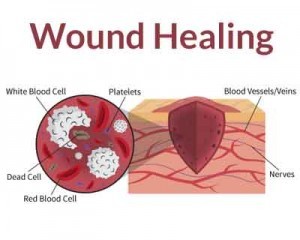- Home
- Editorial
- News
- Practice Guidelines
- Anesthesiology Guidelines
- Cancer Guidelines
- Cardiac Sciences Guidelines
- Critical Care Guidelines
- Dentistry Guidelines
- Dermatology Guidelines
- Diabetes and Endo Guidelines
- Diagnostics Guidelines
- ENT Guidelines
- Featured Practice Guidelines
- Gastroenterology Guidelines
- Geriatrics Guidelines
- Medicine Guidelines
- Nephrology Guidelines
- Neurosciences Guidelines
- Obs and Gynae Guidelines
- Ophthalmology Guidelines
- Orthopaedics Guidelines
- Paediatrics Guidelines
- Psychiatry Guidelines
- Pulmonology Guidelines
- Radiology Guidelines
- Surgery Guidelines
- Urology Guidelines
Laser treatment Improves Scar appearance in wound healing

A new study published in The British Journal of Dermatology reports that Nonablative fractional laser (NAFL)-treated scars showed subtle improvement compared with untreated control scars.
Karmisholt KE and associates conducted a randomized controlled trial to assess scar formation clinically after three nonablative fractional lasers (NAFL) exposures, targeting the inflammation, proliferation and remodeling wound healing phases in patients vs. untreated controls.
Read Also: New lasers effective in genitourinary syndrome of menopause
The researchers performed the study on 32 patients using a split-wound design to assess excisional wound halves treated with 1540-nm NAFL vs. no laser treatment. Three NAFL exposures were provided: immediately before surgery, at suture removal and 6 weeks after surgery. NAFL exposures were applied using two handpieces, sequentially distributing energy deeply and more superficially in the skin (40-50 mJ per microbeam).
The primary outcome was blinded, on-site evaluation using the Patient Observer Scar Assessment Scale (POSAS total; range from 6, normal skin to 60, worst imaginable scar). evaluated at 3 months of follow-up. Secondary outcomes comprised blinded evaluation on the Vancouver Scar Scale (VSS) and standardized assessment comparing scar sides, carried out by blinded on-site, photo and patient assessments.
Read Also: Lasers can help monitor burn wound healing
The key study findings included:
- At the 3-month follow-up, the NAFL-treated scar halves showed improvement compared with the untreated control halves on POSAS total
- The POSAS subitems showed that the NAFL-treated halves were significantly less red and more pliable, and presented with smoother relief than the untreated controls.
- VSS total correspondingly revealed enhanced appearance in the NAFL-treated halves
- The standardized assessment comparing the appearance of scar halves demonstrated a low degree of correspondence between on-site, photo and patient assessments. NAFL-treated scars were rated as superior to untreated scars by 21 of 29 patients.
A non-ablative laser generates beams of coherent light using a very narrow range of wavelengths. The light beams selectively target and heat the water chromophore in the skin. As a result, the temperature of the tissue rises which stimulates neo-collagenesis.
For reference log on to https://doi.org/10.1111/bjd.17076

Disclaimer: This site is primarily intended for healthcare professionals. Any content/information on this website does not replace the advice of medical and/or health professionals and should not be construed as medical/diagnostic advice/endorsement or prescription. Use of this site is subject to our terms of use, privacy policy, advertisement policy. © 2020 Minerva Medical Treatment Pvt Ltd